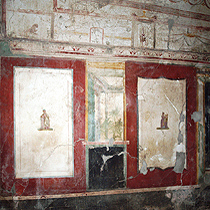 1>
1>No such stunning landscape vistas were viewable from within the closely packed inward facing Pompeian houses and as a result artifice replaced nature. As discussed earlier, this was not achieved by mindless copying or mimicking nature, but by either replacing it or merging it with idiomatic illusions and allusions. On a practical level these were incorporated into window-like or aedicula openings within larger architectonic compositions (fig.1). In some cases these pictorial vistas merged with actual openings onto gardens or peristyle courtyards, thus giving the house an ambiguous relationship with the outside world. On an architectural level this was created by features such as the rectangular space in the atrium above the impluvium, that framed the sky and clouds and allowed rain and light to enter (like a contemporary artwork by James Turrell). Internal windows and doors were also used to enable glimpses into grand peristyle or simple walled gardens, in which cultivated nature was often seen against pictorial backdrops depicting real and romanticized references to nature (fig.2). On a purely illusionary level ‘inside outside’ ambiguity was achieved via sophisticated forms of pictorial virtual realities. These mainly consisted of trompe l’oeil architectural features that framed mythological paintings, ornamental arabesques, visual-metonyms and symbolic references to domestic, state and Imperial cults (fig.3). As Bettina Bergmann observed, ‘The interpenetration of outside and inside and the shifting focus between art and nature create a blurred, hallucinatory experience in which vista and vision are confused’. (‘Painted Perspectives of a Villa Visit: Landscape as status and Metaphor’, in Gazda, E. K., 1991, ed. Roman Art in the Private Sphere, pp.49-67.)
Goethe’s diary entry for March 18th 1787 contains a revealing observation concerning the psychological repositioning of the viewer, as opposed to that achieved by ‘trick of the eye’ techniques. It was written after visiting the Portici Museum near Herculaneum, where he saw many of the household objects retrieved from both excavation sites. “They quite changed my picture of Pompeii. In my mind’s eye its homes now looked more cramped and more spacious – more cramped because I now saw them crowed with objects, and more spacious because these objects were not merely made for use but were decorated with such art and grace that they enlarged and refreshed the mind in a way that the physical space of even the largest room cannot do.” (fig.4). (Goethe, J. W., 1788, Italian Journey. trans. W. H. Auden and E. Mayer, 1962, London Collins ed: p.203.)
If one compares Roman wall-painting with post-seventeenth-century trompe l’oeil, it is apparent that expanding the viewers consciousness was at the heart of Roman domestically located wall-painting. As Goethe observed, it 'refreshed the mind' as opposed to ‘tricking the eye’. It may have started as a relatively inexpensive substitute for marble clad walls, but ideologically and iconographically it evolved into something far more significant.
|